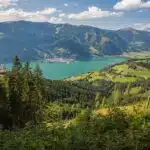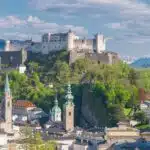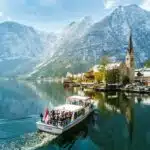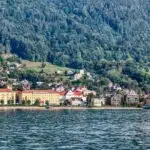Wachau Valley, located along the picturesque stretch of the Danube River between Melk and Krems, is one of Austria’s most scenic regions. Famous for its terraced vineyards, charming villages, historic castles, and cultural heritage, the Wachau Valley offers visitors a delightful blend of natural beauty, history, and world-class wines. A UNESCO World Heritage site, this valley is a must-visit destination for anyone looking to experience the heart of Austria’s countryside.
Exploring the Vineyards: A Wine Lover’s in Wachau Valley
Wachau Valley is renowned for its Riesling and Grüner Veltliner wines, which are produced in the terraced vineyards that line the hills along the Danube. The microclimate and soil make the region ideal for wine production, resulting in some of the best white wines in the world.
- Wine Tasting: Many wineries and “Heurigen” (traditional wine taverns) welcome visitors for tastings. Towns like Dürnstein, Weißenkirchen, and Spitz are known for their wineries where you can sample local vintages.
- Wine Hiking Trails: A popular way to explore the region is by hiking the Wachau World Heritage Trail, which leads through vineyards, orchards, and scenic paths. Walking through these trails offers breathtaking views of the river and valley.
- Wine Events: If you visit in autumn, don’t miss the Wachau Wine Spring, a festival where local vintners open their cellars to celebrate the harvest and let visitors sample the newest wines.


Melk Abbey: A Baroque Masterpiece
At the western entrance of the Wachau Valley lies Melk Abbey, one of Europe’s most magnificent Baroque buildings. This Benedictine abbey, perched on a cliff overlooking the Danube, is both a spiritual and cultural landmark.
- Guided Tours: Visitors can explore the abbey’s opulent interior, including the grand Marble Hall, Library, and Church. The Library is particularly impressive, housing thousands of ancient manuscripts and boasting a beautifully frescoed ceiling.
- Gardens: Don’t forget to stroll through the abbey’s meticulously kept gardens, where you’ll enjoy panoramic views of the valley and river below.
- History and Architecture: Melk Abbey has been a center of learning and culture for over 900 years. Its Baroque architecture, with its golden facade and stunning frescoes, makes it a highlight of any trip to the valley.


Dürnstein: A Town Steeped in History
The charming town of Dürnstein is one of the most popular stops in the Wachau Valley, known for its picturesque streets and historic landmarks. It’s also famous for being the place where King Richard the Lionheart was imprisoned during the Third Crusade.
- Dürnstein Castle: The ruins of the medieval castle still stand high above the town, offering incredible views of the valley. A short hike takes you to the top, where you can immerse yourself in the history of Richard the Lionheart’s imprisonment.
- Stiftskirche: The town’s blue baroque Stiftskirche (Abbey Church) is an iconic landmark that can be seen from miles away. Its tower is one of the most photographed sights in the valley.
- Charming Streets: Wander through the narrow streets of Dürnstein, lined with traditional Austrian houses, wine taverns, and local shops selling apricot products, a regional specialty.

Krems: A Blend of History and Modernity
At the eastern end of the valley lies the city of Krems, a historic town with a vibrant cultural scene. Krems is one of Austria’s oldest cities and has retained much of its medieval charm while embracing modern art and culture.
- Steiner Tor: Enter Krems through the Steiner Tor, a medieval gate that serves as the town’s symbol. The town center is filled with beautifully preserved buildings, cafes, and shops.
- Kunsthalle Krems: For art lovers, the Kunsthalle Krems is a must-visit. This contemporary art museum features rotating exhibitions of Austrian and international modern art.
- Danube Cruises: From Krems, you can take a scenic boat cruise along the Danube, giving you a unique perspective of the valley’s vineyards, castles, and villages.
Spitz: A Quaint Village with Scenic Views
The village of Spitz is a postcard-perfect town, located at one of the narrowest points of the Danube. It’s a peaceful place to take a break and enjoy the slower pace of life.
- The Thousand-Bucket Hill (Tausendeimerberg): Spitz is famous for this hill, which is named for its capacity to produce up to 1,000 buckets of wine. A walk up the hill offers stunning views of the village and the river below.
- Wine and Apricots: Like much of Wachau, Spitz is known for its vineyards and apricot orchards. Be sure to try local apricot jams, schnapps, and pastries made from this prized fruit.
Cycling Along the Danube
For active travelers, cycling is one of the best ways to explore Wachau Valley. The Danube Cycle Path (Donauradweg) runs through the valley, offering cyclists an easy and scenic way to travel between the towns and vineyards.
- Scenic Rides: The route is relatively flat and perfect for cyclists of all skill levels. You can rent bikes in Krems or Melk and take your time exploring the towns, vineyards, and castles at your own pace.
- Bike and Boat: Many visitors combine cycling with a river cruise, allowing for a relaxed and varied exploration of the valley.
Culinary Delights: Apricots and More

In addition to its famous wines, the Wachau Valley is also known for its apricots (called “Marillen” in German). The region’s climate is perfect for growing this fruit, and you’ll find apricot-based products throughout the valley.
Apricot Delicacies: From apricot schnapps to jams, pastries, and even apricot-infused dishes, the local apricot products are a must-try.
Traditional Austrian Cuisine: Enjoy regional specialties like Wiener Schnitzel, Knödel, and Tafelspitz at local taverns, often accompanied by a glass of Wachau wine.
Beyond the Vineyards: Castles and Ruins
Wachau Valley is dotted with historic castles and ruins, each offering a glimpse into Austria’s rich medieval past.
- Aggstein Castle: Perched high above the Danube, the ruins of Aggstein Castle provide one of the most dramatic views in the valley. Explore the castle’s history, including its time as a robber baron’s fortress.
- Schönbühel Castle: At the entrance to Wachau, this castle sits on a rock above the river, resembling a fairytale fortress.

A Timeless Journey Through Wachau Valley
Wachau Valley is a place where history, culture, and natural beauty converge to create one of Austria’s most unforgettable regions. Whether you’re sipping wine at a local vineyard, hiking to a hilltop castle, or simply soaking in the views along the Danube, Wachau offers a timeless and enchanting journey through the heart of Austria. Plan your visit to this UNESCO World Heritage site and discover the magic of Wachau Valley for yourself









